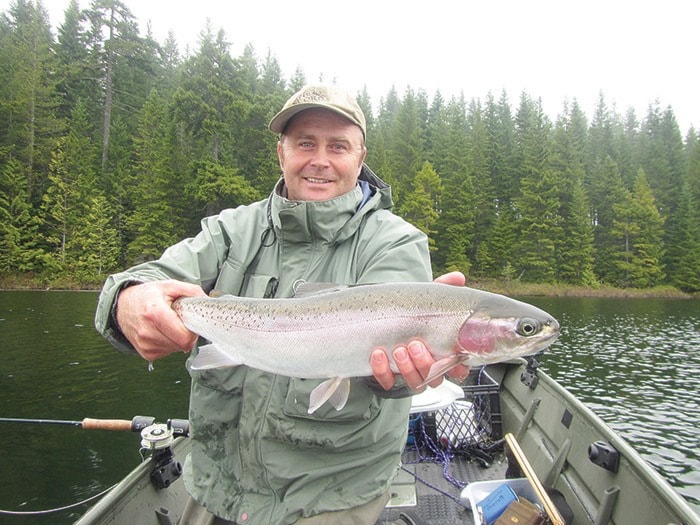After four years, the proof is in the pulling. Pulling, that is, on a hook by big trout in some Vancouver Island lakes.
The trout are getting bigger thanks to a small lake fertilization program started four years ago. It’s a cooperative effort between the Habitat Conservation Trust Foundation (HCTF), the BC Conservation Foundation (BCCF) and the Ministry of Forests, Lands and Natural Resource Operations (FLNRO).
The program’s goal was to increase opportunities for anglers to access quality fisheries targeting larger sized fish in small (less than 1,000 hectares) lakes.
While Vancouver Island is a natural oasis with wonderful lakes all over the place, geology and high rainfall conditions result in relatively unproductive environments.
Their trout aren’t big, unlike the nutrient rich Interior lakes that are world renowned for the large average size of their trout.
But data recently released about the program’s success should have Vancouver Island lake anglers frothing at their gills.
For instance in 2012 (pre-enrichment) a three-year-old fish weighed an average of 660g (1.45 pounds), in 2015 (after enrichment) the same-age fish averaged 1,191g (2.62 pounds).
And one-year-old fish in 2012 averaged 357g (.78 pound), in 2015 and 2016, 568g (1.25 pounds) and 456g (one pound) respectively.
Those figures are from Reginald and Martha Lakes, about 25 km north of Campbell River in the Sayward Forest District.
“We have confirmed significant improved fish growth at both Reginald and Martha lakes — with lots of fish between three and five pounds in Reginald,” said Jeramy Damborg, Project Biologist with BCCF.
That was after a four-year application process.
Similar one-year applications have been completed at Regan Lake (Oyster River wasterhsed), Merrill Lake (Sayward Forest District), Flora Lake (Nitinat District) and Lizard Lake (Renfrew District).
The application process uses a small boat and a fire pump. Nutrients are highly diluted and mixed with lake water before being spread around the lake perimeter at about two week intervals.
The nutrients are then used by the natural algae growing in the lake, boosting algae blooms which in turn increases zooplankton and insect densities — setting up a banquet the feeding trout in Vancouver Island lakes wouldn’t normally receive.
“This, coupled with non-retention and a modified stocking program are producing high quality fisheries,” said Damborg.
The program has also caught the eye of Campbell River Mayor Andy Adams.
“We’re already the Salmon Capital of the World and we have extensive tourism opportunities all around us,” he said. “Campbell River is the launch pad for North Vancouver Island activities and the results coming from this program are really exciting.
“It is creating a whole new opportunity and reason for anglers to visit our city.”
Costs for the programs have been kept low thanks to the help from local angling associations like the Campbell River Fish and Wildlife Association and Comox Valley Fly Fishers Club.
Damborg said that they are looking at other lakes for the program, but the criteria for a fertilization program — like no natural spawning, low flushing and ample shoal area — narrows their choices.
The program doesn’t harm the health of the existing lake he said because, “nutrients have been tested for toxins and water quality is monitored intensively during application.”
Damborg said the Mid Island Castaways Fly Fishing Club in Parksville/Qualicum has expressed interest in starting up a lake near their area and “we are working on finding a suitable one.”
He also said the organization is looking into the possibility of a triploid (sterile) kokanee harvest fishery, with similar nutrient enrichment, for Vancouver Island.
For a program that has enormous economic possibilities now and in the future, one would think there’s a huge investment involved. But nutrients only cost around $4,000 for a medium sized lake, while labor, travel and lab expenses increase total costs to between $10,000 and $15,000 per lake.
Damborg said with increased volunteer support these costs can drop to well below $10K per lake.
